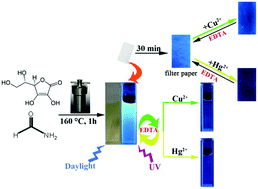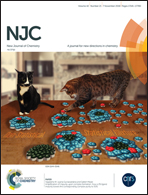Facile preparation of highly sensitive and selective fluorescent paper sensor for the visual and cyclic detection of Cu2+ and Hg2+†
Abstract
The highly luminescent blue fluorescent carbon quantum dots (CQDs) were prepared via the one-step hydrothermal method using L-ascorbic acid (LAA) as a carbon source. The obtained carbon quantum dots (LAA-CQDs) demonstrated high sensitivity and selectivity for detecting Cu2+ and Hg2+ based on the efficient fluorescence quenching effect, with the lowest limits of 7.59 nM and 2.29 nM, respectively. Moreover, LAA-CQDs based paper sensors were fabricated, which showed a clear fluorescence response after being exposed to Cu2+ and Hg2+, with visual detection limits of 5 μM and 3 μM, respectively. The cyclic utilization of the paper sensors was realized by restoring their fluorescence after soaking them in saturated ethylene diamine tetraacetic acid solution. The sensors can be recycled to detect Cu2+ and Hg2+ ions for at least four turns, which was conducive to environmental protection and saving resources. The LAA-CQDs with good environmental applicability have been successfully applied for the detection of Cu2+ and Hg2+ ions in real environmental water samples. In addition, we verified the low toxicity and good biocompatibility of LAA-CQDs via cytotoxicity experiments and cell imaging.



 Please wait while we load your content...
Please wait while we load your content...